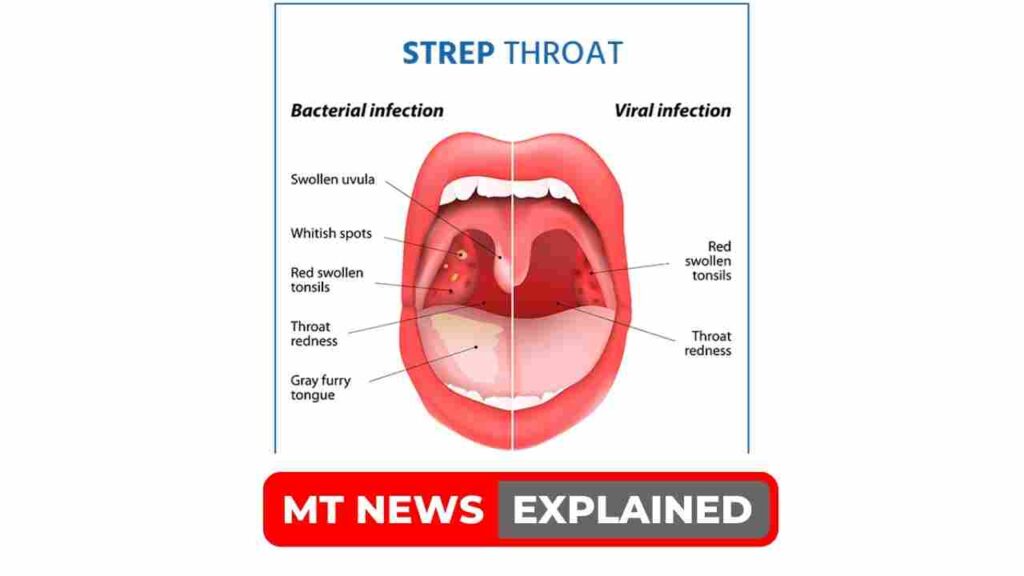
After two children died from the infection in Surrey and Wales, a third youngster passes away from Strep A in a London school. Let’s learn more about the Strep A Scarlet Fever outbreak and How did Hanna Roap die in detail.
Case Overview
- Within a week, a third primary school student in the UK passed away from Strep A.
- The child went to St. John’s School in Ealing, where scarlet fever has been reported.
- The announcement follows the deaths of two young children from invasive Strep A.
Scarlet Fever outbreak: Fourth Child Victim
The fourth child to die from Strep A is a four-year-old boy, with one family “fallen” by the loss of their daughter, 7, as the devastating toll from the bacterial infection rises.
Muhammad Ibrahim Ali, age 4, passed away at home, according to his bereaved family, after the infection claimed the lives of three other primary school students in a matter of days.
Tragically, the bacterial infection has killed four youngsters, one of them, a six-year-old child, passed away in Surrey last week. Three more people passed away in a matter of days, three of them in West London, Wales, and Buckinghamshire.
Today, condolences were expressed for the tragically young victim Muhammad Ibrahim Ali, a student at the Oakridge School and Nursery in High Wycombe, Bucks. According to Muhammad’s mother, Shabana Kousar, “nothing will ever be able to make up for the loss.
He was a great help around the house and quite the adventurer. He loved going on adventures and loved going to forest school. His favorite day was a Monday, and he often claimed that Monday was the best day of the week.
He and his father shared a very strong bond. Also, he accompanied him everywhere and was his best friend. And he merely desired to be near him.
How did Hanna Roap die?
Muhammad’s JustGiving page characterized him as a “beautiful, nice, cheerful, lively guy.” Following the tragic deaths, parents are now being advised to watch out for Strep A infection symptoms.
Little Hanna Roap, another victim, passed away from the infection 24 hours after being unwell, leaving her grieving family in Wales.
A fundraising page created for the young child stated: “Hello, I’m Aysha. I’m organizing a fundraiser in Hanna’s honor after her untimely death on Friday, November 22. She contracted Strep A, which is why she passed away so quickly.
“She was the most lovely, vivacious, endearing lady. The family is devastated. “All proceeds to be donated to the family’s preferred charity.”

School’s Statement
Friends who were aiming to raise £500 for the family’s preferred charity have already tripled that amount. Such awful news, a friend remarked. Greetings to the entire family. Her passing was confirmed by the school and Vale of Glamorgan Council in a statement released yesterday.
“The school and council would like to extend their sincere sympathies to the family at this extraordinarily trying time,” it read.
“The council’s team of educational psychologists supports teachers and students, and when appropriate, parents have received information from Public Health Wales. “The sickness is unlikely to spread to other students, and severe symptoms are incredibly uncommon.

What happened to Hanna?
The danger of infection can be decreased by taking sensible precautions like routine hand washing and staying home from school when you’re sick. One mother paid tribute to the child: “Hanna had a lovely soul. During this terrible time, our thoughts are with you all.”
After developing the invasive infection, which symptoms include high fever, vomiting, and sore throat, Hanna passed suddenly on November 25. A young person who attended St. John’s School in Green Man Gardens, London, was also reported to have died from invasive Strep A earlier today. Pitshanger Lane, a local North Ealing Primary School student, is presently being treated for an unknown ailment in a hospital.
However, a large number of students at this child’s school are absent due to scarlet fever, which is brought on by the Group A streptococcal bacteria that can also bring on invasive strep A.
Although Group Strep Conditions like necrotizing fasciitis and toxic shock syndrome can be brought on by an illness. The two incidents in Surrey and Wales were not connected, according to the UK Health Security Agency.
Dr. Ardiana Gjini’s Statement
In a joint statement made public by the Mirror, it was revealed earlier this week that a student from Victoria Primary School had sadly died after contracting Strep A. The family is going through a very difficult period, and the school and council would like to send their sincere condolences to them.
Dr. Ardiana Gjini, a consultant in communicable disease control for Public Health Wales, said in a statement to MailOnline that the organization was cooperating with the Vale of Glamorgan Council and Cardiff and Vale University Health Board in the wake of a student’s death at Victoria Primary School in Penarth. We send the affected person’s family, friends, and all other parties our sincere sympathies.
What is Strep A – or GAS?
According to the NHS, Strep A, also known as Group A streptococcus (GAS), is a type of bacterium that typically causes no symptoms in humans and is present in the throat and on the skin. This condition is referred to as being “colonized.”
The respiratory tract refers to the nose, throat, and lungs, and it can cause a variety of skin, soft tissue, and respiratory infections.

It can be transmitted via sneezes, coughs, and skin-to-skin contact. Even while those who are carrying the bacteria may not exhibit any symptoms, they are just as likely to spread Strep A as those who are sick and exhibit obvious symptoms.
- Strep Throat
- Cellulitis
- Scarlet Fever
- Streptococcal Toxic Shock Syndrome
- Impetigo
- Rheumatic Fever
- Necrotizing Fasciitis
- Post-Streptococcal Glomerulonephritis
Symptoms
- A fever of 101 F or higher is Red,
- swollen tonsils
- Pain when you swallow
- Swollen and/or tender lymph nodes at the front of your neck
- White patches in the throat
- Tiny red spots on the roof of the mouth (called petechiae)
- Appetite loss Stomachache
- Headache
- Body aches
- Nausea, vomiting
- Loss of appetite
- Rash Cough
- Runny nose
Risk factors
You’re at increased risk of Group Strep A invasive disease if you:
- are in close contact with someone who has the disease
- are over the age of 65
- are diabetic, have heart disease or cancer
- have recently had chickenpox
- have HIV
- use some steroids or intravenous drugs, according to the NHS.
Group Strep A bacteria can also cause scarlet fever, which can be serious if it’s not treated with antibiotics.
Know some facts about Scarlet Fever:
Scarlet fever can be the cause of your child’s sore throat and rash (also called scarlatina). To find out, your child’s doctor can do a simple strep test.
Antibiotics can help your child recover more quickly and avoid long-term health issues if they have scarlet fever. Additionally, antibiotics can aid in keeping others healthy.
A bacterial infection called scarlet fever primarily affects youngsters. It results in a recognizable pink-red rash. Group A streptococcus, also known as Streptococcus pyogenes, is the bacteria that causes the illness and is present in the throat and on the skin. Although there have been a few big outbreaks recently, scarlet fever is generally far less common than it once was.
For instance, according to statistics released by Public Health England, there were 2,830 occurrences of scarlet fever between September 2013 and March 2014. There were a total of 5,746 instances reported for the same period in 2014–15.
Uncertainty surrounds the sudden surge. Knowing the warning signs and symptoms of scarlet fever is crucial for the prompt administration of medications.
(Strep-A) Scarlet Fever outbreak:
Various infections can be brought on by bacteria known as group A Streptococcus (group A strep). Minor illnesses to extremely dangerous and lethal diseases can be caused by these infections.
Scarlet fever can result from the bacterial illness streptococcus, which is mostly mild but can occasionally be fatal. In an email obtained by MyLondon, the North West London Health Protection Team informed the Ealing GPs that numerous primary kids were absent from class due to a variety of viral diseases, including scarlet fever.
The danger of scarlet fever becoming more severe increases during the winter when several viral illnesses are common. Hanna passed away after the first child to pass away from a Strep A outbreak this week, a six-year-old in Year One at a school in Surrey.
At a school near to the one attended by the 6-year-old girl who passed away from the infection, two other cases of Group A streptococcal infection, generally known as Strep A, have been reported. On November 22, a first-grader at the Ashford Church of England Primary School in Ashford, Surrey, passed away.
Strong antibiotics were administered to all of the school’s students and staff by specialists from the UK Health Security Agency. At the neighboring Echelford School, two students in Years 1 and 6 have been diagnosed with Strep A; a third student has the closely related condition scarlet fever. These instances have now been reported to the UK Health Security Agency.
All parents of children at Echelford reportedly received a letter alerting them that the drinking water fountains had been turned off and that staff members were closely watching the students. Senior employees at Echelford reportedly stated that they had been told that parents shouldn’t be excessively concerned and that children should continue to attend school as usual.
They pledged to keep enhancing their emphasis on hygiene throughout the school by enhancing hand hygiene and cleaning important locations.
Awareness of invasive Group A Streptococcal (iGAs) illness
The school and Public Health Wales are collaborating to spread knowledge about invasive Group A Streptococcal (iGAs) illness. Public Health Wales’ Dr. Ardiana Gjini, a consultant in the prevention of communicable diseases, stated:
“Relevant individuals are recommended to become familiar with the symptoms of iGAS infection and what to do if these symptoms develop, even if it is unlikely that their kid will be impacted.
“It is quite uncommon to catch the iGAS disease through contact. Most individuals exposed to Group A Streptococcal infection either remain healthy and symptom-free or suffer minor skin or throat infections.” Parents are urged to consider the nasal flu vaccine for their children when necessary, according to Public Health Wales.
Dr. Gjini continued, “Public Health Wales is collaborating with the Vale of Glamorgan Council and Cardiff and Vale University Health Board following the death of a student at Victoria Primary School in Penarth.
“We extend our sincere sympathies to the victim’s family, friends, and all those involved. Public Health Wales requests that the family’s privacy be maintained as we are unable to comment on specific cases.
KEEP READING,
How did Jonathan Gales die ?Co-founder of British film and Factory Fifteen cause of death explained
Follow us on Twitter for more updates.
Lavanya (Senior Editor) is a full-time content writer with almost 5 years of experience and a part-time teacher. She joined Medico Topics on the Breaking News trainee scheme in 2022 and now works on MedicoTopics.com. As a lifelong learner, She is constantly curious about learning new things and passionate about sharing knowledge with people through her writing and teaching.


